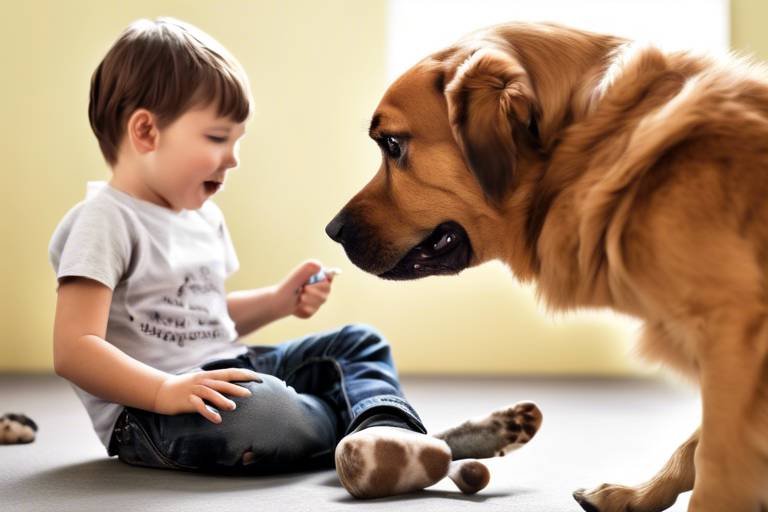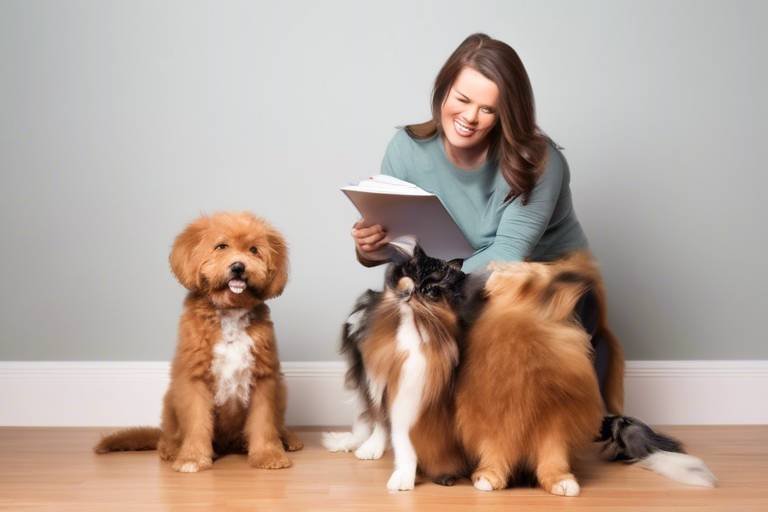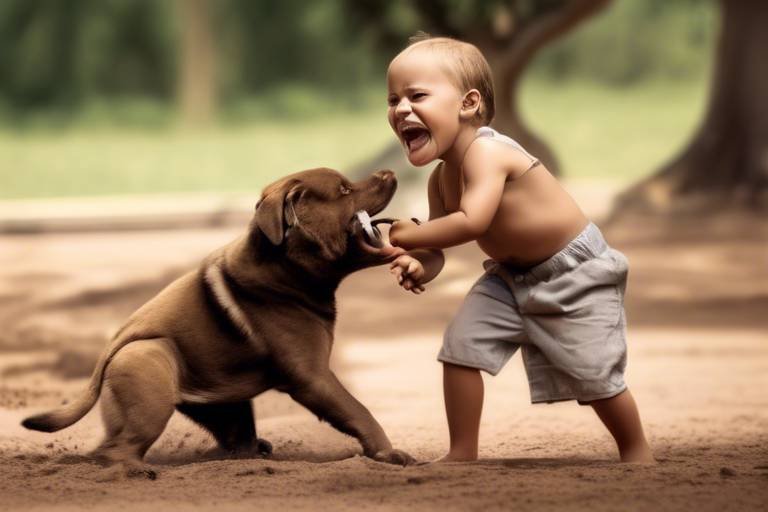How to Help Your Pet Build Healthy Relationships
Building healthy relationships for your pet is not just a luxury; it’s a necessity. Just like humans, pets thrive on social connections and emotional bonds. Imagine your pet as a little sponge, absorbing all the love, attention, and experiences you provide. The more positive interactions they have, the more confident and well-adjusted they become. This article explores various strategies and insights to foster positive connections between your pet and their environment, enhancing their social skills and emotional well-being.
Recognizing your pet's natural instincts and behaviors is crucial. Just like we have our quirks and habits, pets have their own unique ways of expressing themselves. For instance, a wagging tail might indicate happiness, while a tucked tail could signal fear or submission. By understanding these signals, you can better interpret your pet's actions and respond appropriately. This section delves into common behaviors and what they signify, helping you interpret your pet's actions better.
Effective socialization is key to a well-adjusted pet. Think of socialization as the pet equivalent of going to a party; it can be overwhelming at first, but with the right approach, it can lead to fantastic experiences. Here, we discuss methods to introduce your pet to new environments, people, and animals, promoting healthy interactions. The goal is to create a well-rounded pet who feels comfortable in various situations.
Bringing a new pet into your home requires careful planning. Just like introducing a new friend to your circle, you want to ensure everyone feels comfortable. This subsection outlines steps to ensure a smooth introduction and minimize stress for both animals. Start by allowing each pet to get used to the other's scent before any face-to-face meetings. This gradual approach can help ease anxiety and lead to a more harmonious household.
Providing safe spaces for pets during introductions can ease anxiety. Think of it as creating a cozy nook where your pet can retreat if things get overwhelming. Learn how to set up these areas to help pets feel secure and comfortable. A safe space might include a comfortable bed, some favorite toys, and maybe even a piece of your clothing to provide comfort and familiarity.
Observing initial interactions between pets is vital. This segment emphasizes the importance of supervision to prevent conflicts and encourage positive behaviors. You wouldn’t leave two toddlers alone in a room, would you? The same principle applies here. Watch closely for signs of stress or aggression, and be ready to step in if necessary. This attentive approach helps build trust and comfort among your pets.
Play is essential for building bonds. It's not just fun; it's a fundamental part of your pet's social development. This part highlights different types of play and how they contribute to a pet's social development and emotional health. Whether it’s a game of fetch, tug-of-war, or simply chasing after a feather toy, playtime fosters connection and helps your pet learn important social cues. Think of it as their version of a team-building exercise!
Utilizing positive reinforcement can enhance your pet's learning and behavior. Instead of focusing on what your pet does wrong, why not celebrate what they do right? This section explains effective techniques to reward desirable actions, fostering trust and cooperation. By creating an environment where your pet feels appreciated, you pave the way for a stronger bond. A simple “good boy” or a tasty treat can go a long way!
Training your pet using rewards can strengthen your relationship. Discover various reward systems that encourage good behavior and enhance communication between you and your pet. It’s like a secret language that only you two understand! Whether it’s verbal praise, treats, or playtime, find what makes your pet tick and use it to reinforce positive actions.
Consistency in training and daily routines helps build trust. Just like a reliable friend, your pet needs to know they can count on you. This subsection discusses how predictable interactions and responses contribute to a strong pet-owner bond. Establishing a routine for feeding, walks, and playtime can create a sense of security for your pet, making them feel more at home in their environment.
- How can I tell if my pet is feeling anxious? Look for signs like excessive panting, hiding, or aggression. Understanding these signs can help you address their needs.
- What are some good games to play with my pet? Games like fetch, hide and seek, or tug-of-war are excellent for bonding and exercise.
- How long should I socialize my pet each day? Aim for at least 30 minutes of socialization daily, but adjust based on your pet's comfort level.
- Can older pets learn new social skills? Absolutely! While it may take longer, older pets can still benefit from socialization and training.

Understanding Pet Behavior
Recognizing your pet's natural instincts and behaviors is crucial for fostering a harmonious relationship. Just like humans, pets have their own unique ways of communicating and expressing their needs. By taking the time to observe and understand these behaviors, you can interpret your pet's actions better and respond appropriately. For instance, a wagging tail in dogs often signifies happiness, while a cat purring can indicate contentment. However, behaviors can sometimes be misleading, so it’s essential to consider the context in which they occur.
One of the key aspects of understanding pet behavior is recognizing the signs of stress or discomfort. Pets may exhibit various signals when they are feeling anxious or threatened. These can include:
- Excessive barking or meowing
- Hiding or withdrawing from interaction
- Destructive behaviors, such as chewing furniture
- Changes in eating or sleeping patterns
By paying attention to these signs, you can help your pet feel more secure. For example, if your dog is barking excessively, it might be a sign that they are feeling anxious about a new environment or situation. Understanding these cues allows you to address their needs effectively, whether that means providing a safe space or engaging in calming activities.
Another important factor in understanding pet behavior is recognizing their social needs. Pets, especially dogs, are inherently social creatures that thrive on interaction. They often look to their owners for guidance and companionship. Engaging in regular playtime not only strengthens your bond but also helps your pet develop essential social skills. This interaction can take many forms, from simple games of fetch to more complex training exercises.
Moreover, it’s essential to consider the breed and personality of your pet when interpreting their behavior. Different breeds have distinct traits and tendencies. For example, herding breeds like Border Collies may exhibit behaviors that reflect their instinct to herd, such as nipping or chasing. Understanding these breed-specific behaviors can help you tailor your training and socialization strategies effectively.
Ultimately, the key to understanding pet behavior lies in observation and patience. Spend time with your pet, watch how they interact with their environment, and take note of their reactions to various stimuli. This not only enhances your understanding but also deepens the bond you share. As you become more attuned to your pet's behavior, you’ll find it easier to foster positive connections that promote their emotional well-being.

Socialization Techniques
Effective socialization is the cornerstone of a well-adjusted pet. Just like humans, pets thrive on interaction and the ability to connect with their surroundings. Imagine a puppy that has never seen another dog; it might feel overwhelmed or even frightened when faced with new experiences. That's why introducing your furry friend to various environments, people, and other animals is essential for their emotional and social well-being. The process can be both exciting and daunting, but with the right techniques, you can help your pet navigate their social landscape with confidence.
One of the first steps in socialization is to expose your pet to different sounds and sights. For instance, you can take them on walks in bustling areas, visit pet-friendly stores, or even attend local dog parks. Each new experience serves as a building block for your pet’s social skills. However, it's crucial to do this gradually. Overwhelming your pet with too much too soon can lead to anxiety or fear-based behaviors. Think of it as introducing a child to a new school; a little exposure at a time can ease the transition.
When meeting new people or animals, always keep the interactions positive. Use treats or toys to create a fun atmosphere. For example, if your dog is meeting another dog, have both pets on leashes but allow them to sniff each other while you offer treats. This not only distracts them from potential nervousness but also associates new encounters with positive experiences. Remember, the goal is to create a sense of safety and enjoyment during these interactions.
Bringing a new pet into your home can be a thrilling yet challenging experience. It requires careful planning to ensure a smooth introduction and minimize stress for both animals involved. Start by allowing each pet to explore their own space separately before they meet. This way, they can get accustomed to each other's scents without the pressure of face-to-face interaction. After a few days, you can begin supervised introductions, ensuring that both pets are calm and relaxed. If either pet shows signs of aggression or fear, it's best to take a step back and try again later. Think of it as a dance; timing and rhythm are key to making it work.
During the introduction phase, it's vital to provide safe spaces for your pets. These areas should be free of stressors and distractions, allowing your animals to retreat when they feel overwhelmed. For example, designate a quiet room with their favorite toys and bedding where they can feel secure. This not only helps them manage anxiety but also gives them a sense of ownership in their new environment. It's like having a cozy nook at home where you can unwind after a long day—essential for emotional health.
Observing initial interactions between pets is crucial. Always supervise these meetings to prevent conflicts and encourage positive behaviors. Look for signs of stress or discomfort, such as growling, barking, or hiding. If you notice any negative behavior, calmly separate the pets and give them some time apart. This is not a failure; it’s simply part of the learning process. Just like humans, pets need time to adjust to new relationships. By staying attentive, you can help guide their interactions towards a more harmonious outcome.
Remember, socialization is not a one-time event; it’s an ongoing process. Regularly exposing your pet to new experiences, environments, and companions will help them develop into well-rounded, confident animals. Just like building a house, each interaction lays a brick in the foundation of your pet’s social skills. So, be patient, stay positive, and enjoy the journey together!
Q: How long does it take for a pet to become socialized?
A: The timeline varies depending on the pet's age, breed, and past experiences. Generally, consistent exposure over weeks or months is necessary for effective socialization.
Q: Can older pets be socialized?
A: Absolutely! While it might take longer, older pets can learn to socialize with patience and positive experiences.
Q: What should I do if my pet shows aggression towards other animals?
A: It’s essential to consult a professional trainer or behaviorist to address aggression. Never force interactions; instead, focus on gradual exposure and positive reinforcement.
Introducing New Pets
Bringing a new pet into your home can feel like a thrilling adventure, but it also requires careful planning and consideration. Just like humans, pets have their own personalities, quirks, and histories that can influence how they react to new companions. The last thing you want is for your furry friend to feel overwhelmed or threatened. So, how do you ensure a smooth introduction? Let's dive in!
First and foremost, it’s essential to create a neutral environment for the introduction. This means choosing a space that neither pet considers their territory. Doing so can help reduce any feelings of anxiety or aggression. You might want to consider a room where both pets can explore without feeling like they are invading each other’s space. Think of it as setting the stage for a peaceful meeting—just like a first date!
Next, take it slow. Rushing the process can lead to misunderstandings and potential conflicts. Start by allowing the pets to sniff each other's belongings. This will give them a chance to get accustomed to each other's scents without direct confrontation. You can also use a baby gate to create a physical barrier while still allowing them to see and hear each other. This way, they can gradually acclimate to one another’s presence, much like how we warm up to new people in our lives.
Once they seem comfortable, it’s time for the big reveal. Keep both pets on a leash during the first face-to-face meeting. This gives you control over the situation and allows you to intervene if necessary. Make sure to observe their body language closely. Signs of stress can include growling, hissing, or a stiff posture. If you notice any of these behaviors, it’s crucial to separate them and try again later. Remember, patience is key!
To further ease the transition, consider providing safe spaces for each pet to retreat to if they feel overwhelmed. These spaces should be cozy and familiar, equipped with their favorite toys and blankets. This way, they have a sanctuary to escape to whenever they need a break. Think of it as their personal hideaway—a little cave where they can recharge and feel safe.
Finally, after the initial introductions, it’s important to monitor their interactions closely. Supervision is vital, especially in the early days. You want to encourage positive behaviors and intervene if any negative interactions arise. Positive reinforcement, such as treats or praise, can help reinforce good behavior during these interactions. After all, who doesn’t love a little acknowledgment for being on their best behavior?
In summary, introducing new pets is all about creating a calm, controlled environment and taking things at a pace that suits both animals. With patience, careful planning, and a little bit of love, you can help foster a harmonious relationship between your pets that will last a lifetime.
- How long does it take for pets to get used to each other? - It can vary greatly depending on the pets involved. Some may take just a few days, while others might need weeks or even months to fully adjust.
- What should I do if my pets don’t get along? - If you notice persistent aggression or fear, it’s best to consult a professional animal behaviorist for tailored advice.
- Can I use toys during the introduction? - Yes, using toys can help distract and engage both pets, but ensure they are safe and appropriate for both animals.
Creating Safe Spaces
When it comes to introducing new pets into your home, creating safe spaces is essential for easing anxiety and promoting a smooth transition. Think of these spaces as little sanctuaries where your furry friends can retreat to feel secure. Just like we all need a cozy corner to unwind after a long day, pets also benefit from having designated areas where they can relax without feeling overwhelmed. So, how can you create these safe havens for your pets?
First, consider the location of the safe space. It should be a quiet area away from the hustle and bustle of daily activities. You might want to choose a room that is less frequently used or a corner of your living room where they can observe without being directly involved. This gives them a chance to acclimate to their new surroundings at their own pace. Ensure that the space is comfortable by adding a soft bed or blanket, as well as some of their favorite toys. This familiarity will help them feel more at home.
Next, it’s important to establish boundaries. Use baby gates or pet barriers to define the safe area and prevent any unwanted interactions during the initial introduction phase. This way, your new pet can observe the existing pets in the household without direct contact, reducing the chances of stress or aggression. It’s like giving them a front-row seat to the action, but with a safety net!
Moreover, consider incorporating scents into these spaces. Pets rely heavily on their sense of smell, and familiar scents can provide comfort. You can use items like a piece of your clothing or a blanket that smells like their previous home. This simple trick can work wonders in making them feel secure and less anxious.
Lastly, remember that patience is key. Allow your pets to explore their safe spaces at their own pace. Encourage them to use these areas by rewarding them with treats or praise when they do. Over time, they will associate these spaces with positive experiences, which will help them feel more confident and relaxed in their new environment.
- What if my pet refuses to use the safe space? - It's important to give them time. You can try placing treats or toys in the space to encourage exploration.
- How long should I keep the safe space setup? - Keep it in place until your pets are comfortable with each other and the environment. This could take days or even weeks.
- Can I use the safe space for training? - Absolutely! Once your pet feels secure, you can use the space for training sessions to reinforce positive behaviors.
Monitoring Interactions
When it comes to introducing pets, is not just a good idea; it's essential. Imagine throwing a surprise party for your best friend and not keeping an eye on how they interact with the guests. You wouldn't want any awkward moments or mishaps, right? The same principle applies when your pets meet for the first time. By carefully observing their behavior, you can ensure that their initial encounters are positive and stress-free.
During these early interactions, look for signs of comfort or discomfort. Pets communicate in various ways, and understanding their body language can help you gauge how things are going. For instance, a wagging tail generally indicates excitement, while a low posture or tucked tail might suggest fear or submission. Being attentive to these signals can help you intervene if necessary, preventing any potential conflicts before they escalate.
It's also wise to set up a controlled environment for these introductions. Consider having a designated space where both pets can meet without feeling threatened. This could be a room in your home or even a fenced yard. By keeping things calm and controlled, you reduce the chances of overwhelming either pet, allowing them to explore each other at their own pace.
Moreover, supervision is key. Always keep a close eye on their interactions, especially during the first few meetings. If you notice any signs of aggression or anxiety, don't hesitate to step in. This could mean gently separating them or redirecting their attention with toys or treats. Remember, your goal is to create a positive experience that builds trust, not one that leaves either pet feeling scared or anxious.
In addition to direct supervision, consider using tools like baby gates or leashes during introductions. These can provide a physical barrier that allows pets to see and smell each other without direct contact, which can be particularly useful if one or both pets are unsure about the other. This gradual exposure can help them feel more secure and reduce the likelihood of sudden outbursts.
Finally, don't forget to reward positive behavior. If your pets are interacting well, shower them with praise or treats. This reinforcement helps them associate each other with good experiences, paving the way for a lasting friendship. So, keep your eyes peeled, be proactive, and make those first meetings as enjoyable as possible!
- How long should I monitor my pets' interactions? It's best to supervise interactions for at least the first few meetings, gradually reducing your oversight as they become more comfortable with each other.
- What signs indicate my pets are getting along? Look for relaxed body language, playful behavior, and mutual curiosity. If they seem calm and are engaging positively, that's a good sign!
- What should I do if my pets show signs of aggression? If you notice any aggressive behavior, calmly separate them and give each pet some time alone to cool down before attempting another introduction.
- Can I use toys during introductions? Absolutely! Toys can be a great way to redirect energy and encourage positive interactions. Just ensure that each pet has their own toys to avoid possessiveness.
Encouraging Playtime
Playtime is not just about having fun; it’s a crucial element in your pet's social development and emotional health. Imagine a child playing with their friends; they learn to share, communicate, and resolve conflicts. Similarly, when your pet engages in play, they are not only burning off energy but also building essential skills that help them navigate their world. So, how can you encourage more playtime in your pet’s life? Let’s dive into some engaging strategies!
First and foremost, it’s important to understand the different types of play that can benefit your pet. For instance, dogs may enjoy fetching a ball, while cats might prefer chasing a feather toy. Each type of play serves a unique purpose and caters to the specific instincts of your pet. Here are a few examples of play activities:
- Interactive Play: This includes games like tug-of-war or fetch, which require your participation and help strengthen your bond.
- Solo Play: Toys that your pet can play with alone, such as puzzle feeders or chew toys, are great for mental stimulation.
- Social Play: Allowing your pet to interact with other pets can teach them valuable social cues and improve their behavior.
Now, let’s talk about the environment. Creating a play-friendly space in your home can significantly enhance your pet's playtime experience. Make sure there’s enough room for them to run and explore. Consider setting up a designated play area filled with various toys that cater to their interests. Rotate the toys regularly to keep things fresh and exciting. Just as we get bored with the same old routine, so do our pets!
It’s also essential to observe your pet's body language during play. Are they wagging their tail, or do they seem tense? Understanding these signals can help you gauge whether they are enjoying the play or feeling overwhelmed. If your pet shows signs of stress, it might be a good idea to take a break and allow them to calm down. Remember, the goal is to create a positive experience that they will look forward to!
Another effective way to encourage playtime is through positive reinforcement. When your pet engages in play, reward them with treats or praise. This not only reinforces the behavior but also builds a stronger connection between you and your furry friend. The more they associate playtime with positive outcomes, the more they will want to engage in it. Think of it as a dance; the more you practice together, the more in sync you become!
Lastly, don’t forget to join in on the fun! Your participation can turn a simple game into an exciting adventure. Whether it’s chasing a ball or playing hide and seek, being involved shows your pet that you value their playtime. Plus, it’s a great way to bond and create lasting memories together. So, grab that toy and let the games begin!
Q: How often should I play with my pet?
A: Aim for at least 15-30 minutes of playtime each day, but adjust based on your pet's energy levels and preferences.
Q: What types of toys are best for my pet?
A: Choose toys that suit your pet's size and play style. For dogs, consider chew toys and fetch items; for cats, look for feather wands and laser pointers.
Q: How can I tell if my pet is enjoying playtime?
A: Signs of enjoyment include wagging tails, playful barking or meowing, and a relaxed body posture. If they seem overly aggressive or anxious, it may be time to take a break.
Q: Can I play with my pet indoors?
A: Absolutely! Indoor play can be just as stimulating. Use soft toys, interactive games, or even create an obstacle course to keep things interesting.

Positive Reinforcement Strategies
Utilizing positive reinforcement is one of the most effective ways to enhance your pet's learning and behavior. This approach is rooted in the idea that rewarding desired actions encourages your pet to repeat them. Imagine your pet as a little sponge, soaking up all the good vibes and learning from their experiences. When they do something right and it results in a tasty treat or a belly rub, they're more likely to associate that behavior with positive outcomes. It's like a little light bulb going off in their head!
One of the best ways to implement positive reinforcement is through a structured reward system. This can include treats, praise, or playtime, depending on what your pet values most. For instance, if your dog loves to fetch, you might reward them with extra playtime when they bring the ball back. On the other hand, a cat might respond better to a few gentle strokes or a favorite toy. The key is to find out what makes your pet tick and use that as motivation.
Here’s a simple breakdown of how to create an effective reward system:
| Behavior | Reward | Frequency |
|---|---|---|
| Sit on command | Small treat | Every time |
| Come when called | Praise and playtime | Most of the time |
| Not jumping on guests | Special treat | Occasionally |
Another crucial aspect of positive reinforcement is consistency. Pets thrive on routine and predictability. When you consistently reward good behavior, your pet learns to expect a reward for their actions. This consistency not only helps in building trust but also strengthens your bond. Think of it like a dance; when both partners know the steps, the performance is seamless. If you mix up the rewards or are inconsistent in your reactions, it can confuse your pet and hinder their learning process.
Moreover, it’s essential to be patient during this training phase. Like humans, pets have different learning curves. Some may grasp concepts quickly, while others might take a bit longer. Celebrate the small victories, and remember that patience is a virtue. If your pet doesn’t respond immediately, don’t get discouraged. Instead, adjust your approach and try again. Sometimes all it takes is a little tweak in your method to make a world of difference.
In addition to traditional rewards, consider incorporating playtime as a form of positive reinforcement. Engaging in fun activities not only rewards your pet but also reinforces the bond between you. For example, if your dog sits quietly while you’re on a call, rewarding them with a game of tug-of-war can be both fun and beneficial. This not only reinforces their good behavior but also keeps them physically active, which is vital for their overall health.
In conclusion, positive reinforcement is a powerful tool in nurturing your pet's behavior and strengthening your relationship. By understanding what motivates your pet, maintaining consistency, and being patient, you can create a loving environment where your furry friend feels secure and valued. So, the next time your pet does something right, don’t forget to shower them with praise and rewards. It’s a win-win situation for both of you!
- What is positive reinforcement? Positive reinforcement is a training method that involves rewarding desired behaviors to encourage them to be repeated.
- How can I find out what my pet likes as a reward? Experiment with different rewards, such as treats, toys, or playtime, and observe your pet's reactions to determine what they enjoy most.
- How often should I reward my pet? Reward your pet every time they display the desired behavior initially, then gradually reduce the frequency as they learn.
- Can I use negative reinforcement? It's generally more effective to focus on positive reinforcement, as it builds trust and a positive relationship with your pet.
Training with Rewards
Training your pet can sometimes feel like an uphill battle, but it doesn't have to be! One of the most effective methods to teach your furry friend is through reward-based training. This technique not only helps your pet learn commands and behaviors, but it also strengthens the bond between you and your pet. Imagine this: every time your dog sits on command or your cat uses the litter box properly, you reward them with a treat or praise. This positive reinforcement encourages them to repeat the desired behavior, creating a win-win situation!
So, how do you effectively implement this strategy? First, it's essential to identify what motivates your pet the most. For some, it might be tasty treats, while others may respond better to a favorite toy or even a simple belly rub. Understanding these motivators is key to successful training. Once you have that figured out, you can start establishing a reward system that suits your pet's preferences.
Here’s a simple breakdown of how to set up a reward system:
| Pet Type | Preferred Reward | Training Tip |
|---|---|---|
| Dog | High-value treats (like chicken or cheese) | Use treats during training sessions to capture their attention. |
| Cat | Catnip toys or treats | Engage them with toys they love, making training a fun game. |
| Rabbit | Fresh veggies | Incorporate treats into their daily routine to encourage good behavior. |
When training, timing is everything. You want to reward your pet immediately after they perform the desired behavior. This way, they can make the connection between the action and the reward clear in their minds. For instance, if your dog sits when you ask them to, give them a treat right away. This immediate feedback helps reinforce the behavior and makes it more likely that they will repeat it in the future.
Another critical aspect of training with rewards is consistency. Just like in any relationship, being consistent builds trust. Ensure that all family members are on the same page regarding commands and rewards. If one person allows your pet to jump on them while another scolds them for the same behavior, it can create confusion. This inconsistency can hinder the training process and lead to frustration for both you and your pet.
Lastly, remember to keep training sessions short and fun! Pets have limited attention spans, so aim for 5-10 minute sessions a few times a day. This approach keeps your pet engaged and prevents them from becoming bored or overwhelmed. And don’t forget to celebrate small victories! Every time your pet learns something new, it’s a step toward building a stronger relationship.
- How long does it take to see results from reward training? - Results can vary based on the pet's age, breed, and prior training. However, with consistency and patience, many pet owners see noticeable improvements within a few weeks.
- Can I use regular treats for training? - Yes, but it's best to use high-value treats that your pet doesn't get regularly. This makes the reward more special and motivating.
- What if my pet isn’t motivated by treats? - Try different types of rewards, such as toys, playtime, or affection. Every pet is unique, so find what works best for yours!
Building Trust Through Consistency
When it comes to nurturing a healthy relationship with your pet, consistency is the glue that holds everything together. Just like humans, pets thrive on routine and predictability. Imagine how comforting it is to know what to expect each day; your furry friend feels the same way! Establishing a consistent environment helps your pet feel secure, reducing anxiety and promoting a sense of stability.
To build trust through consistency, start by creating a daily routine that includes feeding, playtime, training, and relaxation. This routine not only gives your pet something to look forward to but also reinforces their understanding of what behaviors are expected. For instance, if you always feed your dog at 7 AM, they will learn to associate that time with meals, reducing any anxiety around hunger. Similarly, having a specific time for training sessions can enhance their learning experience.
Another crucial aspect of consistency is maintaining uniformity in your commands and cues. If you use different words or tones for the same action, it can confuse your pet. For example, if you say "sit" one day and "down" the next, your dog may not understand what you want. Stick to a set of commands and ensure everyone in your household uses the same terminology. This clarity fosters trust, as your pet learns to rely on you for guidance.
Additionally, consistency in your reactions to your pet's behavior is vital. If your pet jumps on you for attention and you sometimes reward that behavior with affection and other times scold them, it sends mixed signals. Instead, be consistent in your response: if jumping is not acceptable, always redirect that behavior to something positive, like sitting calmly. This approach not only teaches your pet what is expected but also builds a stronger bond based on mutual understanding.
Moreover, establishing a consistent training schedule can significantly enhance your relationship. Regular training sessions, even if they are short, can foster communication and trust. During these sessions, use positive reinforcement techniques, rewarding your pet for desired behaviors. This not only encourages good behavior but also strengthens the emotional connection between you and your pet.
Lastly, remember that consistency extends beyond just routines and commands; it also involves your emotional responses. Pets are incredibly perceptive and can sense your mood. If you’re inconsistent in your emotional availability—sometimes being affectionate and other times being distant—it can confuse your pet. Aim to be a steady presence in their life, showing love and support consistently. This emotional consistency will help your pet feel safe and valued.
In summary, building trust through consistency is a multifaceted approach that involves establishing routines, using clear commands, responding uniformly to behaviors, maintaining a regular training schedule, and being emotionally available. By embedding these practices into your daily life, you create a nurturing environment where your pet can thrive and develop a deep-seated trust in you. Remember, trust takes time to build, but with patience and consistency, you’ll cultivate a bond that lasts a lifetime.
- How long does it take to build trust with my pet? Trust-building varies by pet; some may take weeks, while others may need months. Consistency is key!
- What should I do if my pet seems anxious? Create a safe space and maintain a routine. Gradually introduce new experiences and be patient.
- Can I train my pet inconsistently? Inconsistency can confuse your pet. Stick to the same commands and responses for effective training.
- How can I tell if my pet trusts me? Signs of trust include seeking your company, following you around, and showing relaxed body language.
Frequently Asked Questions
- How can I tell if my pet is feeling anxious?
Anxiety in pets can manifest in various ways. You might notice behaviors like excessive barking, hiding, or destructive actions. It's important to observe your pet's body language; signs such as a tucked tail, flattened ears, or pacing can indicate stress. If your pet seems unusually withdrawn or aggressive, it might be a sign they are struggling with anxiety.
- What are some effective socialization techniques for pets?
Socialization is all about exposing your pet to new experiences, environments, and other animals in a positive way. Start by introducing your pet to different people and pets gradually. Use treats and praise to create positive associations. Short, controlled interactions are ideal. Remember, the goal is to make these experiences enjoyable, so go at your pet's pace!
- How should I introduce a new pet to my existing pet?
Introducing a new pet can be a delicate process. Begin by keeping them in separate spaces to allow them to get used to each other's scents. When the time comes for their first meeting, do it in a neutral area. Keep the initial interactions brief and supervised. Always reward positive behavior with treats and praise to create a friendly atmosphere.
- What are safe spaces, and why are they important?
Safe spaces are designated areas where your pet can retreat to feel secure and comfortable. These spaces should be quiet and familiar, filled with their favorite toys or blankets. They are crucial during introductions or stressful situations, as they give pets a chance to decompress and regain their confidence away from overwhelming stimuli.
- How can I monitor my pets' interactions effectively?
Monitoring your pets' interactions is essential to ensure everyone is safe and comfortable. Always supervise their initial meetings, and look for signs of stress or aggression. If things get tense, intervene calmly and redirect their attention. Keeping interactions short and positive will help build a healthy relationship over time.
- What types of play are beneficial for my pet?
Play is a fantastic way to strengthen the bond between you and your pet. Different types of play, such as fetch, tug-of-war, or interactive toys, can stimulate your pet both mentally and physically. Engaging in playtime not only helps with socialization but also promotes healthy exercise, reducing anxiety and boredom.
- How does positive reinforcement work in training?
Positive reinforcement is a powerful training technique that involves rewarding your pet for desired behaviors. This could be through treats, praise, or playtime. The key is to be consistent and immediate with your rewards, so your pet associates the good behavior with a positive outcome. This method builds trust and encourages your pet to repeat those behaviors.
- Why is consistency important in pet training?
Consistency in training helps your pet understand what is expected of them. When you maintain a regular routine and respond to behaviors in the same way, it builds a sense of security and trust. This predictability fosters a strong bond between you and your pet, making them more likely to listen and respond positively to your commands.



















